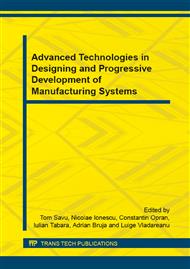[1]
R. K. Raier, H. J. Watson and B. Prince, Management Information Systems, 2nd ed., Wiley (2013).
Google Scholar
[2]
D. Avison, Information Systems Development, 4th ed., McGraw-Hill Education (2006).
Google Scholar
[3]
P. Wallace, Information Systems in Organizations: People, Technology, and Processes, Prentice Hall (2012).
Google Scholar
[4]
V. Majid, N.H.A.I. Farhad, Information technology (IT) for knowledge management, Procedia Computer Science, (2011) 444–448.
Google Scholar
[5]
R. Sharda, Business Intelligence and Analytics: Systems for Decision Support, 10th ed., Prentice Hall (2014).
Google Scholar
[6]
R. Sharda, D. Delen and E. Turban, Business Intelligence: A Managerial Perspective on Analytics, 3rd ed., Prentice Hall (2013).
Google Scholar
[7]
L. Xingsen, Z. Zhengxiang, P. Xuwei, Knowledge Cultivating for Intelligent Decision Making in Small &Middle Businesses, Procedia Computer Science, vol. 1 (2010) 2479–2488.
DOI: 10.1016/j.procs.2010.04.280
Google Scholar
[8]
E. Asfoura, R. Neumann, G. Kassem, R. Dumke, The identifying and adapting of FERP mall form and roles for more trust by marketing of distributed FERP components, Procedia Computer Science, vol. 3 (2011) 11-22.
DOI: 10.1016/j.procs.2010.12.004
Google Scholar
[9]
G. Booch, J. Rumbaugh, I. Jacobson, The Unified Modeling Language User Guide, Addison Wesley (1999).
Google Scholar
[10]
M.S. Neicu, G. Savii, M.C. Benea, Simulated company as validation environment for the design methods and algorithms of informatics systems meant for the business environment, Proceedings of the 15th WSEAS International Conference on Systems (2011).
Google Scholar
[11]
T. Tolio, M. Sacco, W. Terkaj and M. Urgo, Virtual Factory: An Integrated Framework for Manufacturing Systems Design and Analysis, Procedia CIRP, Vol. 7 (2013) 25-30.
DOI: 10.1016/j.procir.2013.05.005
Google Scholar
[12]
M. Sacco, G. dal Masso, F. Milella, P. Pedrazzoli, D. Rovere and W. Terkaj, Virtual Factory Manager, in Virtual and Mixed Reality – Systems and Applications. Lecture Notes in Computer Science, Vol. 6774 (2011) 397-406.
DOI: 10.1007/978-3-642-22024-1_44
Google Scholar


